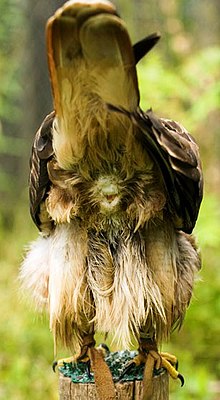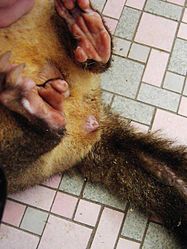Cloaca (biology)

The cloaca ( Latin cloaca , drainage channel) is a common body outlet for the digestive, sexual and excretory organs that is present in many living things . It is a section of the rectum into which the outlet ducts of the genital organs ( gonoducts ) and the ureters open, whose products ( sperm and egg cells ) and excreta, like excrement, are released through the anus .
A cloaca is originally present in all vertebrates , but has been replaced by separate outlets in all real bony fish (Teleostei), the sea cats , some jawless and the higher mammals . There is also a cesspool in some other animal groups such as rotifers and male nematodes .
Cesspool in invertebrates
In most animal groups of invertebrates, the intestine and the ducts of the sexual and excretory organs open out through separate body openings.
In some animal groups, however, a common passage, called a cloaca , was developed independently of one another ( analogously ) . The group of animals with a cloaca, into which the intestines, the urinary bladder and the sexual organs flow, include the rotifers (Rotifera). In the males of the roundworms (Nematoda), the vas deferens open into the intestine, which also forms a cloaca. In the case of sea rollers, the water lungs open into the last section of the intestine and, in some species, the Cuvier's tubes .
Cesspool in vertebrates
In vertebrates , a cloaca is part of the basic pattern, but it was reduced in individual taxa such as the real bony fish (Teleostei), the sea cats , some jawless animals and the higher mammals and replaced by separate outlets. The urinary tract ends in the urodeum formed from the endoderm , which is separated from the coprodaeum by an annular fold .

Cesspool in birds
As with the amphibians and reptiles, there is also a cesspool with the birds . As copulatory the male bird is a penis formed in the vent area for the few groups, such as the running and geese birds is ausstülpbar while a nichtausstülpbarer penis in the form of small erigierbarer protuberances and wrinkles formed in the cloaca in most other species. The erection does not take place via blood filling, but via lymph , which is produced by a vascularized formation in the cloacal wall (lymphobulbus phalli).


Cesspool in mammals
The monotremes ( monotremes ), the only egg-laying mammals , provides the cloaca is an original feature it from the Theria is different and has given them their scientific name. With them, however, the dorsal coprodaeum with the anus is also separated by a fold from the ventral urodaeum with the outlets of the urinary and sexual tracts.
In the higher mammals, a cloaca is only created in the embryo ; in the further course of development, separate body orifices form for the intestine and for the urogenital tract . The cloaca closed by the outer cloacal membrane, as the common origin of the urinary bladder and the rectum, is divided into an anterior and a posterior part in the fourth to seventh week of development (in humans) by the formation of a dividing wall (urorectal septum, the later perineum or perineum ) . The front part is now called the urogenital sinus and is covered by the urogenital membrane, it includes the ducts of the gonads and the urinary tract. In rare cases, this separation can fail, which means that a cloaca can also be pathologically present in humans (persistent cloaca).
Individual mammal species such as the pika , the beaver and some tenreks have developed a secondary cloaca from previously separate orifices , in which the ducts connect just below the body surface and are carried out by a common sphincter.
Cloacal breathing
Some turtles can breathe underwater through the anal bladder , an organ in the cloacal system.
Web links
Individual evidence
- ↑ a b cesspool . In: Pschyrembel Medical Dictionary . 257th edition. Walter de Gruyter, Berlin 1993, ISBN 3-933203-04-X , p. 1648 .
- ↑ a b c d e cesspool . In: Herder-Lexikon der Biologie . Spektrum Akademischer Verlag, Heidelberg 2003, ISBN 3-8274-0354-5 .
- ↑ a b c d Matthias Starck: intestinal tract . In: W. Westheide, R. Rieger (Ed.): Special Zoology . Part 2: vertebrates or skulls . Spektrum, Munich 2004, ISBN 3-8274-0307-3 , pp. 141 .
- ↑ Libbie Henrietta Hyman : A laboratory manual for comparative vertebrate anatomy . 1922.
- ↑ a b Nadja Møbjerg: Organs of osmoregulation and excretion . In: W. Westheide, R. Rieger (Ed.): Special Zoology . Part 2: vertebrates or skulls . Spektrum, Munich 2004, ISBN 3-8274-0307-3 , pp. 151 .
- ↑ D. Jenkins, M. Bitner-Glindzicz, L. Thomasson and a .: Mutational analyzes of UPIIIA, SHH, EFNB2 and HNF1beta in persistent cloaca and associated kidney malformations . In: Journal of Pediatric Urology . tape 3 , no. 1 , 2007, p. 2-9 , PMID 17476318 .
- ^ Renate Angermann: Lagomorpha, Hasentiere . In: W. Westheide, R. Rieger (Ed.): Special Zoology . Part 2: vertebrates or skulls . Spektrum, Munich 2004, ISBN 3-8274-0307-3 , pp. 528 .
